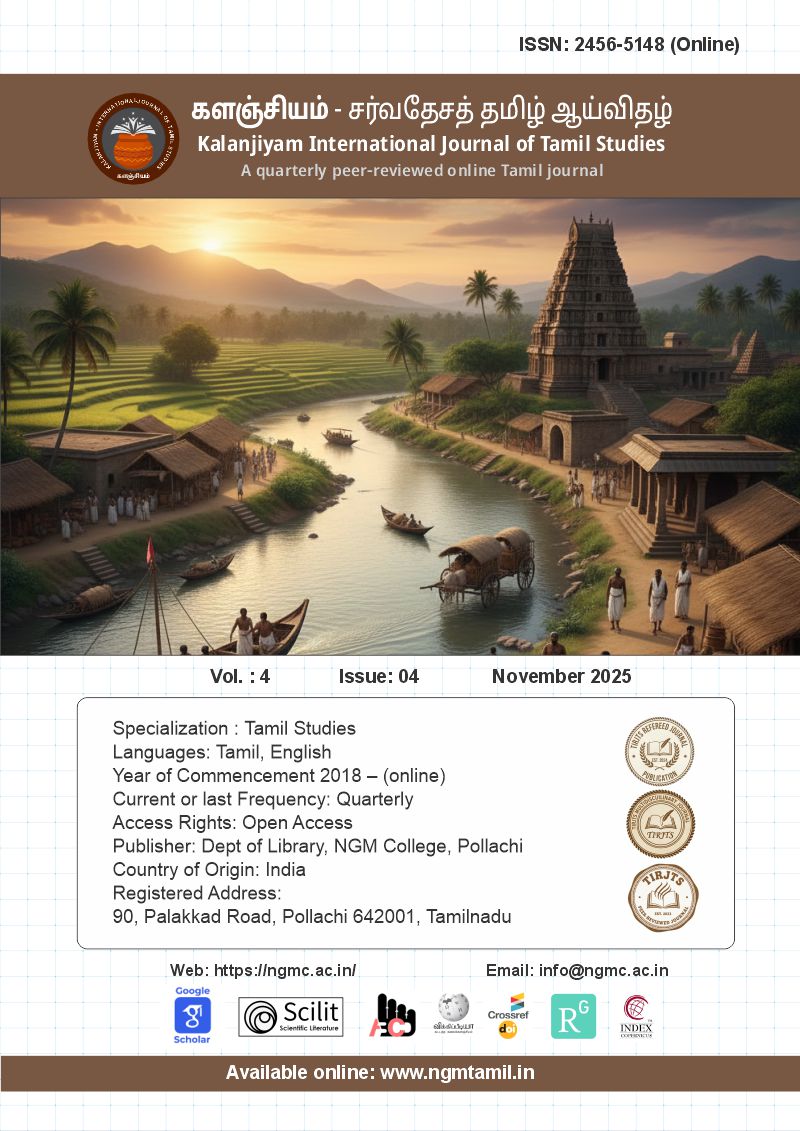தொல்காப்பியத்தில் திணைச் சொல்லின் வகைமைப்பாடுகளும் வினைச் சொல்லீறுகளின் பாலியல் குறியீடுகளும்: ஓர் அமைப்பியல் ஆய்வு
The Classification of Tiṇai Nouns and the Gender Markers of Verbal Endings in Tolkappiyam: A Structural Study
Keywords:
Tolkappiyam, Tiṇai, Uyartiṇai, Akṟiṇai, Pāl (Gender), Āṭūu Aṟicol, Verbal Endings, Aṉmaik Kiḷavi, Tamil GrammarAbstract
This study analyzes the structural and functional aspects of tiṇai categorization, one of the central concepts in Tamil grammar, based on the Collatikaram (section on morphology) of Tolkappiyam. The research establishes that the dichotomous classification of words into uyartiṇai (Rational Class) and akṟiṇai (Non-Rational Class) is not merely a biological division, but rather an intellectual centering rooted in the concept of 'makkaṭ cuṭṭē' (human reference/rational designation). Uyartiṇai is further subdivided into masculine (āṇpāl), feminine (peṇpāl), and common plural (palarpāl), while akṟiṇai is divided into singular non-human (oṉṟaṉpāl) and plural non-human (palaviṉpāl), totaling five gender categories (pāl).
The primary focus of this study is on the subtle grammatical contribution of the 'eleven letters' (ன், ள், ர், ப, மார், து, று, டு, அ, ஆ, வ) that function as verbal endings, clearly denoting these five pāl categories. These specific suffixes ensure tiṇai-pāl agreement within the agglutinative structure of the Tamil language. Furthermore, the study elucidates Tolkappiyar's method of 'logical determination' (tarkka rītiyāṉa varaiyaṟai), which resolves ambiguity in tiṇai or pāl through 'aṉmaik kiḷavi' (negation). This research illuminates the deep semantic and morphological structures embedded within Tamil grammar.
தமிழ் இலக்கணத்தின் மையக் கருத்தாக்கங்களில் ஒன்றான திணைப் பாகுபாட்டின் அமைப்பியல் மற்றும் செயல்பாட்டைத் தொல்காப்பியச் சொல்லதிகாரத்தை அடிப்படையாகக் கொண்டு இந்த ஆய்வு பகுப்பாய்வு செய்கிறது. உயர்திணை (Rational Class) மற்றும் அஃறிணை (Non-Rational Class) எனச் சொற்களை இருவகைப்படுத்துவது, வெறுமனே உயிரியல் பிரிவல்ல; மாறாக, 'மக்கட் சுட்டே' என்ற அறிவார்ந்த மையப்படுத்தலை அடிப்படையாகக் கொண்டது என்பதை ஆய்வு நிறுவுகிறது. உயர்திணை ஆண்பால், பெண்பால், பலர்பால் எனவும், அஃறிணை ஒன்றன்பால், பலவின்பால் எனவும் ஐம்பால்களாகப் பிரிக்கப்படுகின்றன. இந்த ஆய்வின் முக்கிய கவனம், ஐம்பால்களையும் தெளிவாக உணர்த்தும் வினைச்சொற்களின் ஈற்றில் அமையும் 'பதினேரா ரெழுத்துக்களின்' (ன், ள், ர், ப, மார், து, று, டு, அ, ஆ, வ) நுட்பமான இலக்கணப் பங்களிப்பின் மீது செலுத்தப்பட்டுள்ளது. இந்த எழுத்துகள் தமிழ் மொழியின் ஒட்டுநிலை (Agglutinative) கட்டமைப்பில் திணை-பால் ஒருமைப்பாட்டை உறுதி செய்கின்றன. மேலும், திணை அல்லது பாலில் ஐயம் ஏற்படும்போது, 'அன்மைக் கிளவி' (Negation) மூலம் ஐயத்தைப் போக்கும் தொல்காப்பியரின் தர்க்கரீதியான வரையறை (Logical Determination) முறையும் ஆய்வில் விளக்கப்பட்டுள்ளது. இந்த ஆய்வானது, தமிழ் இலக்கணத்தின் சொற்பொருள் மற்றும் உருபனியலின் ஆழமான கட்டமைப்பை வெளிப்படுத்துகிறது.
Downloads
References
1. Tolkāppiyar. Tolkāppiyam: Sollaṯikāram (Word Authority).
2. தொல்காப்பிய நூற்பாக்கள் குறிப்புகள் (Citations of Nūṟpās):
3. இந்த ஆய்வில் குறிப்பிடப்பட்ட தொல்காப்பியச் சொல்லதிகார நூற்பாக்கள் பின்வருமாறு:
தொல், சொல்: 1, 2, 3, 4, 5, 6, 7, 8, 9, 10, 24, 25.
Downloads
Published
Issue
Section
License

This work is licensed under a Creative Commons Attribution 4.0 International License.
Our journal adopts CC BY License Creative Commons Attribution 4.0 International License http://Creativecommons.org//license/by/4.0/ . It allows using, reusing, distributing and reproducing of the original work with proper citation.


